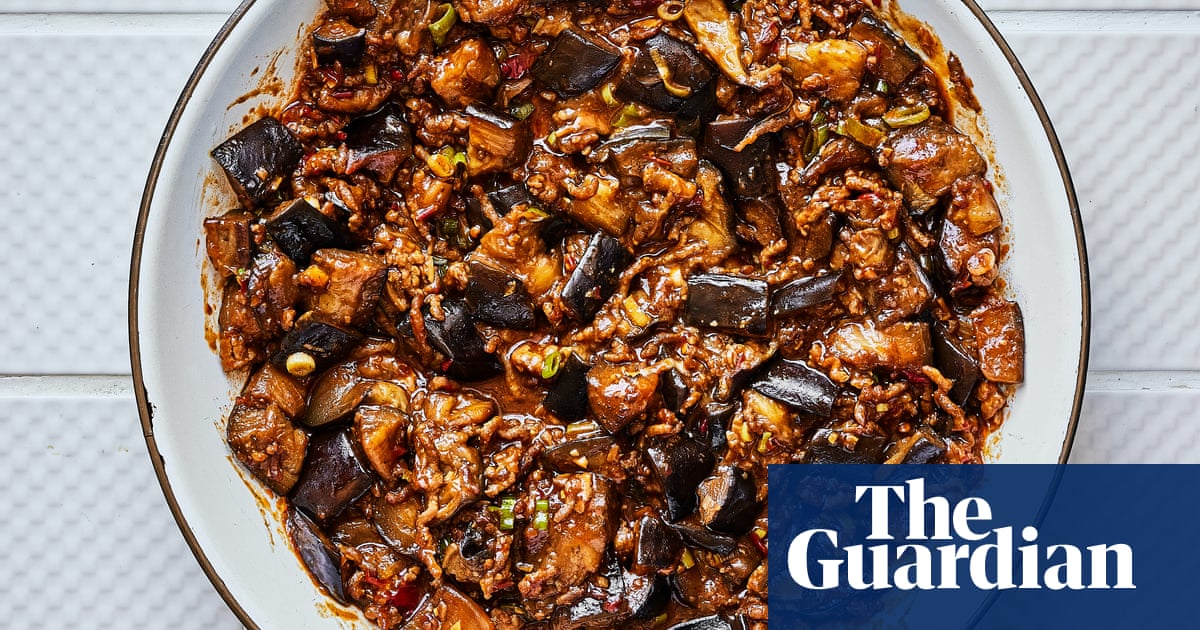Anyone who’s spent time in Japan will know the hold that Kewpie roasted sesame dressing has on local palates. Creamy, slightly tangy, savoury, full of roasted flavours and a little sweet, it’s the ideal dressing for absolutely anything. It comes in squeezy bottles and is now widely available in larger supermarkets, but I’ve created my own version here in case you can’t find it. These lettuce cups make a fresh and crunchy snack that serves as a vessel for tender chicken and whatever herbs you have in the fridge. But first, a Japanified rendition of the Chinese dish mapo tofu, only more savoury and salty, and with a slightly thicker sauce. It’s a strong contender for weekly dinner rotations, depending on what you have in your fridge, of course.
I love the combination of pork mince and aubergine, but this also works well with tofu. You can even make it vegetarian or vegan by omitting the meat and using tofu or vegan mince and substituting vegetable stock powder. It’s a little spicy, very savoury and super-saucy, so is perfect for topping steamed rice and eating with a spoon. Negi is a type of Japanese spring onion – if you can find them, use them instead of the spring onion. Doubanjiang, also called fermented chilli bean paste or spicy bean paste, is a fiery, savoury paste made from fermented broad beans. You can find it in Asian food stores and in many supermarkets.
Prep15 minCook35 minServes4
1 tbsp neutral oil, such as rapeseed or sunflower, plus extra as needed100gpork mince4 small aubergines, or 100g firm tofu, cut into cubes1 garlic clove, peeled and finely grated2cmfresh root ginger,peeled and finely grated½ spring onion, or ½ negi,finely sliced1 tsp cornflour1 tsp toasted sesame oilSteamed rice, to serve
For the sauce1 tbsp brown miso1½ tbsp doubanjiang1 tsp soy sauce1 tsp sugar1 tsp powdered chicken stock, or vegetable stock
For the sauce, put the miso, doubanjiang, soy sauce, sugar and stock powder in a bowl, add 200ml water, mix well and set aside.
Put the oil in a frying pan on a medium heat and, once it’s hot, add the pork mince and cook, stirring to break it up, for about five minutes, until the fat has rendered out and the meat is browned and crisp. Using a slotted spoon, transfer the pork to a plate, leaving the oil behind in the pan. Add the aubergine to the pan (and a touch more oil, if need be) and cook gently, turning often, for six to eight minutes, until browned all over and meltingly tender.
Return the pork to the pan, add the garlic and ginger, then cook, stirring gently so as not to break up the aubergines, for two to three minutes, until fragrant. Stir in the sauce mixture, leave to simmer for two to three minutes, then add the spring onion and cook for five minutes more, until the sauce has reduced.
Mix the cornflour with two tablespoons of water and tip into the pan, mixing gently. Simmer for two to three minutes, until the sauce thickens, then stir in the sesame oil.
Serve immediately alongside a pile of steamed rice.
For the chicken, I’ve used a microwave for speed – you’ll be surprised at just how much moisture the meat retains when it’s cooked this way, and that it cooks in mere minutes. For those without a microwave, poach it instead, or use leftover roast or rotisserie chicken.
Prep10 minCook20 minServes2 as a snack
100gchicken breastPinch of salt1 tbsp sake½ cucumber, julienned1 tbsp gari(pickled ginger), or peeled and very finely sliced fresh root ginger1butterhead lettuce
For the dressing2 tbsp mayonnaise1½ tbsp toasted sesame seeds,plus extra to serve1 tsp neutral oil, such as rapeseed or sunflower1 tsp apple cider vinegar1 tsp soy sauce1 tsp sugar1 tbsp water
To serve (all optional)1 handfulfresh coriander leaves, or other herbs, roughly chopped2 spring onions, finely sliced
Slice the chicken lengthways into two long strips and put these on a microwave-safe plate. Season with the salt and sake, then cover with clingfilm and microwave at 160W for two and a half to three minutes, or until cooked through. Remove from the microwave and, once the chicken is cool enough to handle, shred it with a fork.
Combine all the dressing ingredients in a bowl and whisk. (This will make more dressing than you need here, but it keeps well in the fridge for a few days, so enjoy the rest with just about any salad.)
Mix the shredded chicken with three to four tablespoons of the dressing, the cucumber and ginger. Separate the lettuce into leaves to make cups and fill them with the chicken mixture. Serve topped with coriander, spring onions and extra toasted sesame seeds, if you like.
These recipes are edited extracts from Umai: Recipes From a Japanese Home Kitchen, by Millie Tsukagoshi Lagares, published by Quadrille at £27. To order a copy for £24.30, go toguardianbookshop.com
